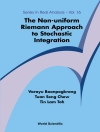This monograph provides a concise presentation of a mathematical approach to metastability, a wide-spread phenomenon in the dynamics of non-linear systems – physical, chemical, biological or economic – subject to the action of temporal random forces typically referred to as noise, based on potential theory of reversible Markov processes.
The authors shed new light on the metastability phenomenon as a sequence of visits of the path of the process to different metastable sets, and focuses on the precise analysis of the respective hitting probabilities and hitting times of these sets.
The theory is illustrated with many examples, ranging from finite-state Markov chains, finite-dimensional diffusions and stochastic partial differential equations, via mean-field dynamics with and without disorder, to stochastic spin-flip and particle-hop dynamics and probabilistic cellular automata, unveiling the common universal features of these systems with respect to their metastable behaviour.
The monograph will serve both as comprehensive introduction and as reference for graduate students and researchers interested in metastability.
Cuprins
Part I Introduction.- 1.Background and motivation.- 2.Aims and scopes.- Part II Markov processes 3.Some basic notions from probability theory.- 4.Markov processes in discrete time.- 5.Markov processes in continuous time.- 6.Large deviations.- 7.Potential theory.- Part III Metastability.- 8.Key definitions and basic properties.- 9.Basic techniques.- Part IV Applications: Diffusions with small noise.- 10.Discrete reversible diffusions.- 11.Diffusion processes with gradient drift.- 12.Stochastic partial differential equations.- Part V Applications: Coarse-graining at positive temperatures.- 13.The Curie-Weiss model.- 14.The Curie-Weiss model with a random magnetic field: discrete distributions.- 15.The Curie-Weiss model with random magnetic field: continuous distributions.- Part VI Applications: Lattice systems in small volumes at low temperatures.- 16.Abstract set-up and metastability in the zero-temperature limit.- 17.Glauber dynamics.- 18.Kawasaki dynamics.- Part VII Applications: Lattice systems in large volumes at low temperatures.- 19.Glauber dynamics.- 20.Kawasaki dynamics.- Part VIII Applications: Lattice systems in small volumes at high densities.- 21.The zero-range process.- Part IX Challenges.- 22.Challenges within metastability.- 23.Challenges beyond metastability.- References.-Glossary.- Index.
Despre autor
Anton Bovier is Professor of Mathematics at the University of Bonn. His research concerns applications of probability theory in physics and biology, with a focus on statistical mechanics, metastability and ageing. He has published over 130 scientific papers, and a monograph on “Statistical Mechanics of Disordered Systems”. He is a Fellow of the Institute for Mathematical Statistics. He is member of the Clusters of Excellence “Hausdorff Centre for Mathematics” and “Immuno Sensation”, both at the University of Bonn.
Frank den Hollander is Professor of Mathematics at Leiden University. His research focuses on probability theory, statistical physics, population dynamics and complex networks. He has published over 150 scientific papers, and two monographs on “Large Deviations” and “Random Polymers”. He is a member of the Royal Dutch Academy of Sciences, and a Fellow of the American Mathematical Society and of the Institute of Mathematical Statistics. He is recipient of a 5-year Advanced Grant by the European Research Council and a 10-year consortium grant by the Dutch Ministry of Education, Culture and Science.












